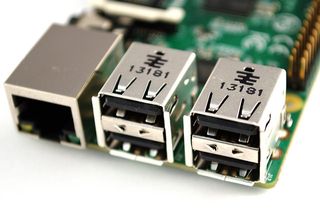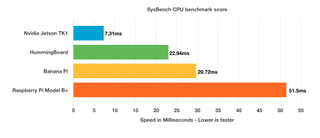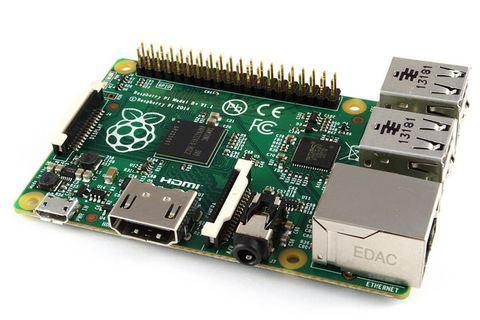IT Pro Verdict
The Raspberry Pi Model B+ is an undeniable improvement over its predecessor. Extra USB ports mean you no longer require a hub, and more reliable power circuitry means fewer crashes.
Pros
- +
Affordable; Extra USB ports; Improved reliability; More efficient
Cons
- -
Some add-ons won't work; Same processor and RAM; Shifted mechanical layout
Anyone expecting the Model B+ to be an all-out redesign of the popular development board will be disappointed. While the B+ has a re-jigged layout with more input options, the use of the same processor and RAM as its predecessor classifies this as a minor refresh.
The biggest changes come in two areas: the USB ports have been doubled to four, and the general-purpose input-output header has been boosted from 26 pins to 40 pins. The design of the board has also been altered. With rounded the corners the entire unit can fit in an Altoid or Curiously Strong Mints tin, something hobbyists frequently use as cases for their creations. Plus there are four mounting holes, so it's easier to attach to a wall or anywhere else you wish.

Additional changes in the board's design include the removal of the composite video connector in favour of a combined audio-video socket. This won't win the B+ any fans in developing countries, where a special splitter cable (not provided) will be required to mate it to a TV.
A refreshed power supply circuit replaces linear regulators with a switch-mode supply for considerable improvements in power draw.
Compatibility
The latest Raspberry Pi isn't compatible with all accessories for its predecessors as it doesn't share a common circuit board layout with the Model A or B. You'll have to start by purchasing a compatible case.
A bigger issue comes in the new GPIO header. Extended to 40 pins from the original's 26, the GPIO header of the Model B+ is designed to be electrically compatible with accessories developed for the original: the first 26 pins are identical. The redesign loses, however, the P5 header added in the Model B Revision 2 and Model A, used by accessories like the Wolfson Audio Card to gain access to digital audio input and output. As a result, these add-ons won't operate.

There's better news when it comes to the software. The Model B+ uses the same Broadcom BCM2835 system-on-chip processor as all other Raspberry Pi models, including the Compute Module. Any software written with a Pi in mind will run on the Model B+ without modification. Users will just need to ensure their operating system images are up to date before moving across to the Model B+, to ensure drivers for the new network controller are in place.
Performance
Using the same chip and 512MB of memory as the existing Pi, the Model B+ comes with no improvements to performance. This means it doesn't challenge the competitors such as the HummingBoard and the Banana Pi.
This appears to be a missed opportunity given the age of the BCM2835. Originally designed for set-top boxes, the chip was obsolete when the first Model B launched in 2012. Although it provides capable multimedia facilities, its general-purpose performance is woeful - not helped by its use of the outdated ARMv6 instruction set architecture, rather than the newer ARMv7 chosen by its competitors.
The SysBench CPU benchmark confirms the Model B+ lacks the performance of its more expensive rivals.

Those moving from an existing Pi will see none of the performance gains that can be won by moving to a rival platform. What they will find is improved reliability, brought about by the more efficient switch-mode power supply circuitry. Unlike the linear regulator of the original design, the Model B+ can cope with variable voltages - meaning cheaper power supplies incompatible with previous Pi models should work fine on the Model B+.
Overall
In some ways, the Model B+ is a disappointment. It's the same software and processor, with the identical amount of memory. Unless you were short of GPIO pins, there's little to gain from moving to the new board aside from a reduction in power draw and a slightly smaller footprint.
Still, the Raspberry Pi remains a leader in the hobbyist embedded platform market. Its community is as vibrant as ever - a advantage over rival platforms.
Add-on developers can be assured of compatibility between all revisions, providing the P5 header isn't used. With the B+ available for the same price as a B, it represents a great investment for newcomers to world of Pi. However, those there's little on offer here for existing users to upgrade immediately.
One thing that will be in the B+'s favour in the future is compatibility with Hardware Attached on Top (HAT), a new standard for add-on boards which allows for plug-and-play support by using two of the new GPIO pins for board identification. If you're developing add-ons for the Pi and have not yet investigated the HAT standard, we'd advise doing so as soon as possible - especially given HAT modules will be compatible with earlier Raspberry Pi models too, minus the plug-and-play functionality.
Verdict
The Raspberry Pi Model B+ is an undeniable improvement over its predecessor. Extra USB ports mean you no longer require a hub, and more reliable power circuitry means fewer crashes.
OS: Raspbian Linux (Pidora, OpenElec, Raspbmc, RISC OS, Arch compatible)
Processor: 700MHz Broadcom BCM2835, one ARMv6 core
Graphics: Dual-Core VideoCore IV
Memory: 512MB DDR
Storage: None on-board, requires optional micro-SD card to boot
Connectivity: SMSC LAN9515 USB hub and 10/100 Ethernet controller
Ports: 1x HDMI, 4x USB 2.0 with partial compatibility, 1x DSI, 1x CSI, 1x analogue AV (stereo audio and composite video), 40x GPIO, 1x Ethernet
Power Draw: ~1.5W idle, ~3W under load
Size: 82.5mm x 57.5mm x 19.8mm
Weight: 41g
Gareth Halfacree is an experienced tech journalist and IT professional, and has been writing since 2006. In addition to contributing article for ITPro, Gareth has been featured in publications such as PC Pro, Techmeme, The Register, The MagPi, and Tom’s Hardware.
In addition to his digital articles, Gareth is the author of several best-selling books. These include the Raspberry Pi User Guide, an essential text for those looking to get started with their Raspberry Pi, as well as The Official Raspberry Pi Beginner’s Guide. Gareth also wrote the Official BBC micro:bit User Guide, a comprehensive guide to setting up the pocket-sized computer, learning to code on it, and even creating your own hardware addons.


